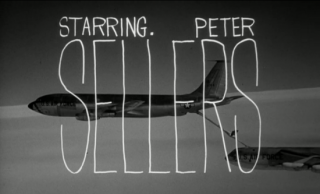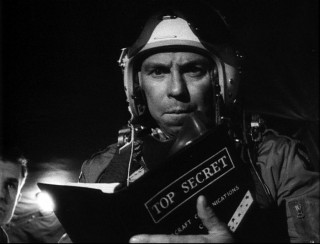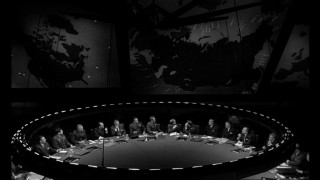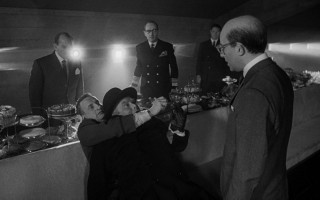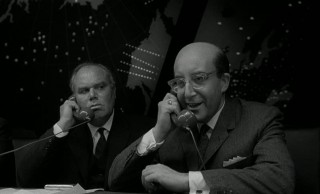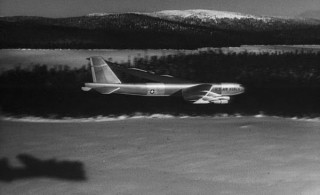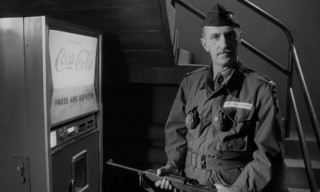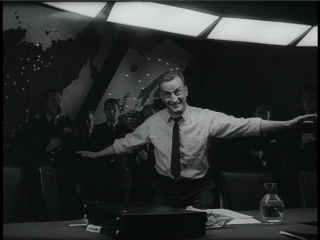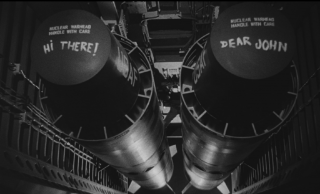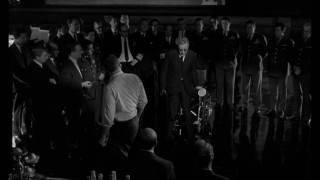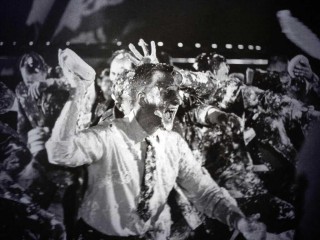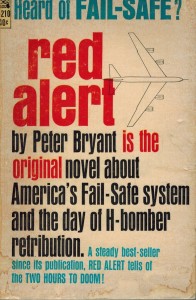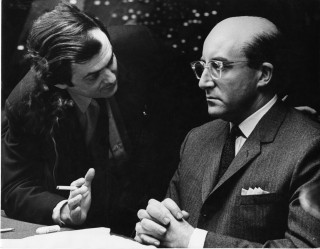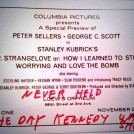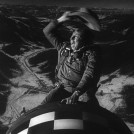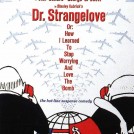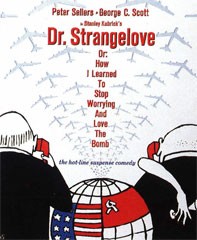
On Sept. 25, 1961, President John F. Kennedy addressed the United Nations General Assembly in which he can be quoted as saying, “Every man, woman and child lives under a nuclear sword of Damocles, hanging by the slenderest of threads, capable of being cut at any moment by accident or miscalculation or by madness.” This was three years before his assassination would move the original release date of Dr. Strangelove or: How I Learned to Stop Worrying and Love the Bomb, which was eventually released on Jan. 29, 1964.
The film is as politically significant and relevant now as it was then because those weapons, capable of annihilating us all, still exist today. It may have been a byproduct of its time, but the Cold War came close many times to being, in reality, a Hot War. In fact, as recently as 2014, an article in The New Yorker was printed aptly titled, “Almost Everything in ‘Dr. Strangelove’ was True.”
Before and after the movie, people in positions of power spoke of deterrence and of doomsday devices, though to our knowledge none were ever completed.
The film starts with a narrator saying, “For more than a year, ominous rumors had been privately circulating among high-level Western leaders that the Soviet Union had been at work on what was darkly hinted to be the ultimate weapon: a doomsday device. Intelligence sources traced the site of the top secret Russian project to the perpetually fog-shrouded wasteland below the Arctic peaks of the Zhokhov Islands. What they were building or why it should be located in such a remote and desolate place no one could say.”
This sets the tone of the film, which then shows us Burpleson Air Force Base, where General Jack D. Ripper, played by Sterling Hayden, puts the base on “Red” and has initiated Wing Attack Plan R.
Ripper tells Group Captain Lionel Mandrake, one of three key roles played by Peter Sellers, of a quote Clemenceau once said about war. “He said war was too important to be left to the generals. When he said that, 50 years ago, he might have been right. But today, war is too important to be left to politicians. They have neither the time, the training, nor the inclination for strategic thought. I can no longer sit back and allow Communist infiltration, Communist indoctrination, Communist subversion, and the international Communist conspiracy to sap and impurify all of our precious bodily fluids.” I know, it sounds crazy, but crazy has existed in the real military since the beginning of organized armed forces.
The next thing we here is the narrator again. “In order to prevent against surprise nuclear attack, America’s Strategic Air Command maintains a large force of B-52 bombers, airborne, 24 hours a day. Each B-52 can deliver a nuclear bomb load of 50 megatons, equal to 16 times the total explosive force of all the bombs and shells used by all the armies in World War 2. Based in America, the Airborne Alert Force is deployed from the Persian Gulf to the Arctic Ocean, but they have one geographical factor in common – they are all two-hours from their targets inside Russia.”
When the B-52 gets its instructions, Major T.J. “King” Kong, played by Slim Pickens, exchanges his government issued helmet for his own cowboy hat and says “Well, boys, I reckon this is it – nuclear combat toe-to-toe with the Roosskies.”
Lt. Lothar Zogg, the bombardier played by a very young James Earl Jones in his first film role, asks if this is some kind of loyalty test, but Kong just replies with the fact that no one has ever received the go order. The music plays a big part in this film, specifically with the scenes in the B-52, because it’s a humming of the “Ants Go Marching,” with a background of military drums, that do in fact speed up the beat, each time a scene happens in the B-52.
In the War Room, General “Buck” Turgidson, played by George C. Scott, explains the provisions for Plan R to President Merkin Muffley, the second of Sellers’ pivotal roles in the movie. Buck is of the impression that since there is no going back, an all-out attack would catch the Russians with their pants down. President Merkin is not impressed, nor is he happy with the “acceptable losses” Buck talks about when saying that “I’m not saying we won’t get our hair mussed.” Merkin then calls for the Russian Ambassador to come to the War Room, to make a call to the Russian Premier.
A scene interjecting the War Room stuff is one back on the B-52, where Major Kong says “Survival kit contents check. In them you’ll find: one .45 caliber automatic; two boxes of ammunition; four days’ concentrated emergency rations; one drug issue containing antibiotics, morphine, vitamin pills, pep pills, sleeping pills, tranquilizer pills; one miniature combination Russian phrase book and Bible; $100 in rubles; $100 in gold; nine packs of chewing gum; one issue of prophylactics; three lipsticks; three pair of nylon stockings. Shoot, a fella’ could have a pretty good weekend in Vegas with all that stuff.”
He was originally supposed to say Dallas, and he did, but since this movie was released after the assassination of JFK, they overdubbed Dallas for Vegas, but if you read his lips, you can see him say Dallas.
Back in the War Room, Buck and the Russian Ambassador Alexi de Sadesky, played by Peter Bull, get into a fight, because Buck caught him spying on the War Room, to which the President says the now famous line, “Gentlemen, you can’t fight in here! This is the War Room.” Next up is a phone call to Premier Kissoff, while other troops attempt to enter Burpleson Air Base to get the recall code, for the planes.
After some pleasantries with the drunk Premier, the Merkin starts with “Now then, Dmitri, you know how we’ve always talked about the possibility of something going wrong with the Bomb…” This is quite the light touch, of saying, “Hey, we’re bombing you,” but it adds a human element to President Merkin, that can be found in all of Peter Sellers’ three roles in the film.
The conversation ends, as Alexi learns that the Doomsday device has been completed, to which he then explains the machine. President Merkin, calls on his top science advisor, Dr. Strangelove, the third and possibly best of Sellers’ three roles, to explain the plausibility of the doomsday device. After explaining the device, Strangelove comes to his final and most important point, “Of course, the whole point of a Doomsday Machine is lost, if you *keep* it a *secret*! Why didn’t you tell the world, EH?” Meanwhile, the President makes arrangements to tell Russian Air Control, where the B-52’s are headed and other information, to prevent one getting through to set off the doomsday device.
Back at Burpleson, Ripper is talking about fluoridation and explaining his take on it being a Commie plot to Mandrake as they are fighting for their lives. During one of these dog fight scenes, outside the base is a sign that clearly reads, “Peace is our Profession,” which is part poetic, part satire in its very own way. When, at last, Ripper’s men surrender, he goes into the bathroom and shoots himself.
Back on the B-52, the music and humming now a little more frantic, as one of the missiles sent to destroy them is avoided, blowing up near the plane, causing a fire and destroying the radio, but not the plane as a whole. Losing fuel as they are, they fly below radar and try to regroup.
At Burpleson, Colonel “Bat” Guano, played by Keenan Wynn, enters the base to find Mandrake and a dead Ripper. He has no knowledge of what is going on and is really just a straight soldier, whose only goal is to get Ripper on the phone with the President. After some protesting from Mandrake, Guano allows him to make a phone call from a phone booth on the base. After several attempts, Mandrake realizes that he doesn’t have the money to make the call, so he asks Guano for some change, to wit Guano replies, “What, you don’t think I’d go into combat with loose change in my pocket, do you?”
Then comes Guano’s time to shine, when Mandrake asks him to shoot the lock off of a Coca-Cola machine.
“That’s private property,” Guano replies, before being convinced to shoot it and then replies, “Okay. I’m gonna get your money for ya. But if you don’t get the President of the United States on that phone, you know what’s gonna happen to you? … “You’re gonna have to answer to the Coca-Cola company.” It’s a small scene in a big movie, but amid all of the comedy that exists in this black comedy – or satire if you prefer – it has always had a lasting impression on me.
Mandrake’s call proves useful and the remaining planes are recalled, save for one, which a celebrating War Room only finds out about when the Russian Premier calls to let them know there’s one left. Knowing what their two targets are, President Merkin tells Kissoff to put all he has into those two targets, even though the plane is flying below radar.
Now, comes General Buck Turgidson’s shining moment, when Merkin asks him if the pilot has a chance to make it through. Buck’s response is excited which then turns to sadness. He eagerly answers, “If the pilot’s good, see, I mean if he’s reeeally sharp, he can barrel that baby in so low… oh, you oughta see it sometime. It’s a sight. A big plane like a ’52… varrrooom! Its jet exhaust… frying chickens in the barnyard!” And when he finishes his statement he realizes he’s supposed to be rooting for the plane to NOT make it.
What the War Room and the Russians don’t know is that Kong wants to hit any target he can, and with their fuel loss due to the fire, they change targets, and once they’ve settled on a target they can reach, they start the bomb run, with the humming and drums peaking in intensity and volume. But the bomb run itself is so specific and detailed, it’s almost like you’re on the plane with them, flipping the switches and checking the dials.
During the bomb run, the bomb bay doors malfunction and Kong goes down to the bowels of the plane to fix them. Sitting on one of the bombs he works on the electronics. The two bombs in the frame have stuff written on them, “Hi, there” is the one that Kong is sitting on, while the other bomb says, “Deary John.” By the time he gets the doors fixed and open, the bombs are dropped, creating the iconic scene, that is always described as Slim Pickens riding the bomb down, and never Kong rides the bomb down. That scene, possibly Pickens’ most famous scene, was a last minute inspiration that had to be turned from idea to shooting in 48 hours. But, of course, it worked.
Back at the War Room, Dr. Strangelove breaks the dejected silence by talking about survival down at the bottom of some of the deeper mines. He peaks Tugidson’s and Merkin’s interest when he speaks of a ten to one male female ratio. Then Turgidson starts going off about a Mine Shaft Gap with the Russians. But the film takes its final bow as Dr. Strangelove stands up and shout, “Mein Fuhrer, I can walk!” Then the bombs start to explode while the classic “We’ll Meet Again,” featuring Vera Lynn.
That wasn’t the original end to the film. The original end to the film is possibly the most famous deleted scene in film history, “the ending that never was” if you will. The original end had the War Room break out in a pie fight, with a shot of President Merkin being hit in the face and someone saying “the President’s been hit.” Aside from the respect for the recently assassinated President Kennedy, the scene was cut from the film due to its making a mockery of the film as a whole, and it’s better for not having it in the final cut.
This film is more like a play, in that it really focuses on three locations; the War Room, the B-52 plane, and Burpleson Air Force Base mainly Ripper’s Office. You could cut the film into just the scenes that take place in those locations and make it a play, if you wanted to. It’s truly that simple in its linear storytelling. It proves that you don’t need a lot of locations to make a good film.
It is a brilliant, if not scary, satire or black comedy. Call it what you will, but we have come damn close to the real thing. Accidents, false reports, phantom radar blips, you name it. The picture started out as a serious film with the first screenplay titled, “Edge of Doom”, but Kubrick’s audible on the script is well done, bringing in Terry Southern to punch up the funny. Kubrick’s brilliance is that he knew that this nightmare could only be absorbed via comedy.
Dr. Strangelove or: How I Learned to Stop Worrying and Love the Bomb is an excellent metaphor for an era that we can think of as over, but really it’s an era that has yet to end because the weapons still exist.
The film was based on the book Red Alert by Peter George, although in the opening credits, there is a small typo and it just says “Base on the” instead of “based.” So far as I can tell, it’s the only mistake in the whole film. Sellers’ improvisation is forever part of film history in this cinematic masterpiece. And his trademark of playing multiple roles in the same film is reprised and best known for what he did in Strangelove. Sellers was supposed to play four parts, but a broken leg prevented him from playing Kong. It’s just as well, because the three parts he played were done so flawlessly, and Slim Pickens was a great casting choice.
There are some other great stories about the filming of the movie. They ran into some trouble with the United States Air Force because of the B-52 interior set. It was so realistic that they had to show their sketches to prove that they didn’t break any laws and steal any secrets to create the set. Kubrick was also wary of another film in development at the time, based along similar lines called Fail Safe. But he and Columbia Pictures drew up a lawsuit that made sure Dr. Strangelove would be released first, and it worked as Fail Safe wasn’t released until the following year.
All of these amazing stories and this amazing film was done on a production budget of a mere $2 million, which is pennies compared even to today’s flops. It was groundbreaking in its scope and story, in addition to the trailers and posters that changed the game for movie promotion.
It has spawned a genre of doomsday films that reappear every so often, and even contemporary classics like WarGames, owe some debt to Dr. Strangelove.
Of Kubrick’s many films, this is arguably the best and definitely my favorite of them all. If he had never directed again, this would have still garnered him enough fame to make him still part of the cultural lexicon.
If you haven’t already, see the movie. It needs to be part of the curriculum for anyone in the military and especially any politicians on any Armed Forces subcommittee. It’s that important. For those who still don’t get the point that there are no “acceptable losses,” they should be forced to watch WarGames, and if that doesn’t work they should be impeached or removed from having any stake over military decisions.
